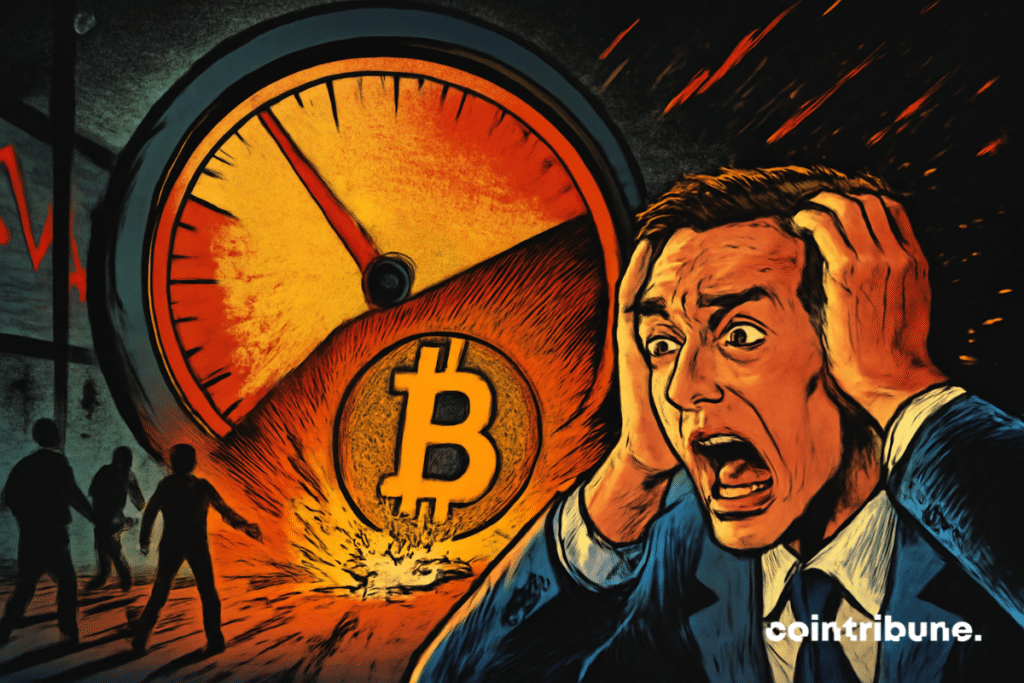Smaller $BTC holders are stepping up.
— glassnode (@glassnode) October 16, 2025
Strong accumulation is underway among small to mid-sized cohorts (1–1000 BTC), while large holders have slowed distribution, signaling renewed confidence in spite of the recent shakeout. pic.twitter.com/LYFeGjrc3k
A
A
Bitcoin : The Fear In The Market Could Lead To A New Accumulation Phase
Fri 17 Oct 2025 ▪
4
min read ▪ by
Getting informed
▪
Bitcoin (BTC)
Summarize this article with:
This week, the bitcoin fear and greed index dropped to its lowest level in a year, plunging investors into uncertainty. This sudden decline fuels speculation : should one give in to panic or take advantage of this correction to accumulate at low prices? For Bitwise analysts, this fear phase could actually signal the start of a new accumulation cycle, thus offering a strategic investment opportunity in a volatile market.

In Brief
- The fear and greed index has reached its lowest level in a year, raising questions about market direction.
- Geopolitical tensions and massive futures liquidations have amplified this correction.
- According to Bitwise analysts, this fear phase could mark the beginning of an accumulation cycle rather than a crisis.
- Small BTC holders are increasing their purchases despite a general feeling of panic.
A Drop in Market Sentiment: Between Liquidation and Fear
The decline of the fear and greed index to 24, its lowest level since 2023, echoes particularly tense market conditions, as evidenced by the recent crypto crash.
Indeed, after reaching a level of 71 last week, this indicator drastically dropped, signaling a panic atmosphere widely shared by market participants. Here are the key factors explaining this drop :
- Geopolitical tensions : these growing tensions between the United States and China have revived fears of global economic instability, amplifying the negative sentiment around risky assets, including bitcoin ;
- Massive futures liquidations : A record wave of liquidations occurred on perpetual futures contracts, resulting in the loss of nearly 11 billion dollars, an event that exacerbated the bearish pressure on the market ;
- A general negative sentiment : this drop in the fear and greed index was fueled by a sharp decline in public interest in bitcoin, with a notable drop in Google searches, suggesting a temporary disengagement of retail investors.
As highlighted by Bitwise analysts, this decline is not simply the result of a technical correction but also a series of external factors.
“The recent correction was amplified by geopolitical tensions, notably between the United States and China, which revived concerns about global economic instability,” they explain.
The consequences of this sentiment decline go beyond a simple price drop. According to experts, this collective fear, similar to that observed during previous major corrections in 2018 and 2022, triggered a massive wave of bitcoin futures liquidations.
“The liquidations on perpetual futures contracts were record-breaking, exceeding 11 billion dollars, an unprecedented figure,” states Bitwise, adding that this influx of forced sales largely helped exhaust selling pressure. This process seems to have created a situation where, paradoxically, fear could actually pave the way for an accumulation phase.
The Dynamics of Accumulation and Mining Companies’ Pressure
Despite this palpable fear atmosphere, several indicators show that small investors are taking advantage of this situation to accumulate more bitcoin. Glassnode data indicates that holders of small amounts of BTC, between 1 and 1,000 BTC, have significantly increased their purchases, unlike large institutional players who seem hesitant.
“We are witnessing a rise of small players, a dynamic that might signal a form of market resilience against negative pressure,” says Max Shannon, analyst at Bitwise.
However, this accumulation scenario is not without challenges. Mining specialists, traditionally considered contrarian actors, have taken opposite measures. CryptoQuant data specifies that nearly 51,000 BTC have been sent to exchange platforms in recent days, a practice that often precedes significant selling periods.
Bitwise analysts highlight that these movements by mining companies could signal an additional short-term pressure risk, thus creating tension between small investors and the major market players.
While the accumulation observed among small investors could feed a long-term rebound, pressures exerted by mining companies and institutional holders remain elements to closely monitor. The coming months could see a market adjustment, with a gradual return of confidence or a new phase of volatility.
Maximize your Cointribune experience with our "Read to Earn" program! For every article you read, earn points and access exclusive rewards. Sign up now and start earning benefits.
A
A
Diplômé de Sciences Po Toulouse et titulaire d'une certification consultant blockchain délivrée par Alyra, j'ai rejoint l'aventure Cointribune en 2019. Convaincu du potentiel de la blockchain pour transformer de nombreux secteurs de l'économie, j'ai pris l'engagement de sensibiliser et d'informer le grand public sur cet écosystème en constante évolution. Mon objectif est de permettre à chacun de mieux comprendre la blockchain et de saisir les opportunités qu'elle offre. Je m'efforce chaque jour de fournir une analyse objective de l'actualité, de décrypter les tendances du marché, de relayer les dernières innovations technologiques et de mettre en perspective les enjeux économiques et sociétaux de cette révolution en marche.
DISCLAIMER
The views, thoughts, and opinions expressed in this article belong solely to the author, and should not be taken as investment advice. Do your own research before taking any investment decisions.